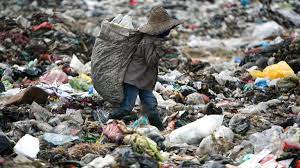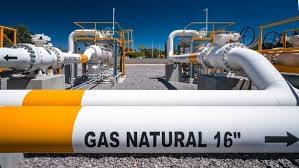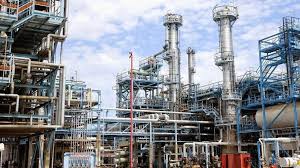Oil & Energy
‘Renewable Energy Waste Crisis Is Much Worse Than You Think’

Waste disposal is not a popular topic of discussion in the media when it comes to renewable energy. Most of the coverage that solar and wind power is getting is strongly positive, with a focus on falling costs and rising efficiencies, as well as government plans for huge increases in installed capacity. Yet problems tend to lurk and wait to spring up. Now, the waste problem is springing up.
TheInternational Renewable Energy Agency (IRENA) estimated in 2016 that unless we made significant changes to our treatment of solar panels, they could add up to 78 million tons of waste. The IRENA did not phrase it this way. It said that “recycling or repurposing solar PV panels at the end of their roughly 30-year lifetime can unlock an estimated stock of 78 million tonnes of raw materials and other valuable components globally by 2050.”
The thing is that most panels do not live to see their 30th birthday, as an article in the Harvard Business Review from June pointed out. Solar waste, it said, is growing much faster than it should have, theoretically. This is because another thing that you wouldn’t see widely publicised is solar panels beginto lose efficiency from the moment they are installed.
Meanwhile, new, more efficient panels are being developed. Even if the loss of efficiency is minuscule, at an average 0.5 percent, that figure is off the top of a typical efficiency rate of less than 30 percent (light-to-electricity conversion), so when offered a higher efficiency installation, many residential solar owners would consider it. The authors of the article, dubbed The Dark Side of Solar Power, point to the continuous improvements in solar panel technology as a reason for shorter actual lives for residential panels. They note that thanks to these improvements, both in cost and efficiency, consumers are a lot less likely to wait for their panels to turn 30 before they replace them. As a result, these early replacements could lead to 50 times more solar panel waste than IRENA had forecast.
It’s worth noting that IRENA’s forecast for the 78-million-ton opportunity from solar panel waste was made in 2016. A lot of things have changed over the past five years, including the rate of growth in solar panel installations. Unfortunately, what hasn’t changed a lot is the economics of recycling solar panels.
Grist reported recently that, according to researchers and recycling industry insiders, the cost of recycling a solar panel varies between $12 and $25. Meanwhile, the income from recovering certain elements from it comes in at about $3. According to the National Renewable Energy Laboratory, recycling a solar panel costs between $20 and $30, while sending it to a landfill costs $1-2. And while the EU has put in place recycling mandates, the U.S. has no such mandates on a national level.
This massive difference in the cost of recycling versus the cost of dumping panels at landfills hints at an unpleasant truth that we are seeing in the EU already. There are recycling mandates there. The countries with the highest solar capacity pay the most for their electricity. This could, of course, be a coincidence, but that’s quite unlikely: recycling costs money, and somebody has to foot that bill.
It is this bill that busts the myth of the cheap solar power that can fuel the whole world because the sun is there and shines for free. This is true. But once you add the costs of recycling to the total cost of solar energy, as the Harvard Business Review authors note, the cost of solar jumps four times.
The future, in the absence of quick action, looks bleak, according to the researchers who penned the HBR article.
“If we plot future installations according to a logistic growth curve capped at 700 GW by 2050 (NREL’s estimated ceiling for the U.S. residential market) alongside the early replacement curve, we see the volume of waste surpassing that of new installations by the year 2031,” Atalay Atasu, Serasu Duran, and Luk N. Van Wassenhove wrote.
“By 2035, discarded panels would outweigh new units sold by 2.56 times. In turn, this would catapult the LCOE (levelised cost of energy, a measure of the overall cost of an energy-producing asset over its lifetime) to four times the current projection. The economics of solar so bright-seeming from the vantage point of 2021 would darken quickly as the industry sinks under the weight of its own trash.”
This sounds bad enough. It’s even worse because there are only a handful of companies in the U.S. that recycle solar panels. But there is also wind turbine blade waste that is building up, and while, unlike solar panels, it does not contain toxic materials, the sheer size of the blades makes it a significant waste problem. Wind turbine blades are not recyclable yet, and tons of them are coming to landfills over the next 20 years; more than 720,000 tons in the U.S. alone.
“Because there are so few options for recycling wind turbine blades currently, the vast majority of those that are no longer able to be used are either stored in various places or taken to landfill,” says CEO, and co-founder of CruxOCM, Vicki Knott.
“While the waste stream represents only a tiny portion of municipal solid waste, it’s clearly not an ideal scenario. As wind turbines are being replaced, there’s certainly a need for more creative recycling solutions for used blades,” Knott also said.
It all sounds like a waste nightmare scenario, and it pretty much is.
While many residential solar panels will live out their lives, many others will not. But this is only the beginning of the problem. Recycling costs must be brought down and capacity built before the current wave of utility-scale solar farm additions subsides because anything done later would be playing catch-up with little chance to win.
Slav writes for Oilprice.com
By: Irina Slav
Oil & Energy
FG, MEMAN Chart Ways To Safe Petroleum Products Delivery

The Federal Government and key Petroleum Products marketers have proposed new measures to help curb rising cases of road accidents involving petrol tankers.
This followed recent incidents of road accidents resulting in cremation of hundreds of lives and causing extensive damage to properties.
Speaking at the Discourse organised by Mejor Energy Marketers Association of Nigeria (MEMAN) in Lagos, Thursday, with the theme “Improving Safe Transportation of Petroleum Products”, the Minister of State for Petroleum Resources (Oil), Heineken Lokpobiri, noted with dismay the number of casualties the country recorded recently due to tanker accidents.
Lokpobiri stressed the need for an enhanced training for tanker drivers, installation of detection leak devices as well as other safety systems that can assist drivers.
He called on Marketers and Federal Road Safety Commission (FRSC) to strengthen collaboration with stakeholders, especially in the training of tanker drivers.
On his part, the Minister of State for Petroleum Resources (Gas), Ekperikpo Ekpo, reaffirmed government’s commitment to providing enabling environment to ensure safety of petroleum products transportation.
Ekpo, who was represented by Engr. Abel, said consideration should be given to more safety means of transporting products like the pipelines and railway line.
He stressed the need for better training for drivers and implementation of safety regulations within the industry.
Earlier, Chairman, MEMAN, Huub Stokman, said the Association has elaborate training manual for members truck drivers.
Stokman insisted that more training programmes and consistent adherence to safety measures would help to curb road accidents involving tanker drivers.
Also speaking, the National President, Nigerian Association of Raod Transport Owners (NARTO), Yusuf Lawal Othman, called for support.
Oil & Energy
Benue To Pioneer Gas Production From Coal – NGEP

The Chairman, National Gas Expansion Programme (NGEP), Prof. Mohammed Ibrahim, has said that the production of coal bed methane, an unconventional form of natural gas extracted from coal, is set to begin in Benue State.
Prof. Ibrahim staed this while addressing newsmen at the end of a joint meeting of the National and State gas expansion committees with Benue State Governor, Hyacinth Alia.
He said the Federal Government is committed to expanding gas availability in Nigeria for domestic use and mobility.
Ibrahim added that extracting gas from unconventional coal sources rather than traditional hydrocarbon reserves is a way to boost gas availability.
“Essentially there are four areas of implementation that the committee has identified. One is to pioneer the production of gas from what you call coal bed methane, which means that Benue is going to pioneer in the country the production of gas not from conventional hydrocarbon, but from non-conventional coal just so that the nation will have an alternative source to gas availability”, he said.
Also speaking, the Chairman, Benue State Gas Expansion Programme, Dr. Emmanuel Chenge, said the gas expansion initiative would contribute to the economic transformation of Benue State.
“The good news is that Benue is set to join the league of gas-producing states and if we are conversant with what being a member of the gas-producing state is, it shows that Benue State will start getting derivatives from that sector of the economy”, Dr Chenge stated.
The National Gas Expansion Programme (NGEP) was established to boost the exploration and utilisation of gas in Nigeria and make Nigeria a gas-based industrial nation by increasing the use of gas for transportation, cooking, and industrialization.
Oil & Energy
NNPC Debunks Explosion Claim In Warri Refinery

The Nigeria National Petroleum Company Limited (NNPCL) has said there was no explosion at the newly refurbished Warri Refining and Petrochemical Company (WRPC).
NNPCL’s Chief Corporate Communications Officer, Olufemi Soneye, made this known in a statement issued on Friday night.
Soneye said reports claiming that there was an explosion at the Warri refinery were false and should be ignored and disregarded by the public.
According to him, the refinery was undergoing routine maintenance.
His statement read, “NNPC Ltd. wishes to clarify that there was no explosion at the Warri Refining and Petrochemical Company (WRPC). Any reports suggesting otherwise are completely false.
“On January 25, 2025, operations at WRPC Area 1 were intentionally curtailed to carry out necessary intervention works on select equipment, including field instruments that were impacting sustainable and steady operations.
“These intervention works are essential to ensure the production of on-specification finished and intermediate products, particularly Automotive Gas Oil (AGO) and Kerosene (Kero).
“The routine maintenance is progressing as planned, and Area 1 will be back in operation within the next few days.
“Despite ongoing interventions, over the past 11 days, AGO loading has been maintained at an average of eight trucks per day, with a sufficient supply available to sustain ongoing truck load-out operations”.
Soneye added that the NNPCL was committed to ensuring an uninterrupted supply of petroleum products from the refinery.
He said the company “appreciates the patience and cooperation of all stakeholders as it completes these essential maintenance activities”.
-

 Niger Delta5 days ago
Niger Delta5 days agoNDDC Begins N50,000 Monthly Payment To 10,000 N’Delta Youths
-

 Sports2 days ago
Sports2 days agoChelsea Fall Short Against Brighton
-

 News2 days ago
News2 days agoNigeria, Venezuela Explore Mining Opportunities
-
Niger Delta5 days ago
Police Nab Pupil For Threatening Schoolmates With Pistol
-

 News5 days ago
News5 days agoRetirement: Ignore PSC’s Directive, Remain In Office, IGP Tells Officers
-

 Politics2 days ago
Politics2 days agoAhead 2027, Obidient Movement Engages Stakeholders In Borno
-
Maritime2 days ago
Navy Rids Calabar Waterways Of Piracy, Oil Bunkering
-
Business5 days ago
FG Targets Reduction In External Borrowing

